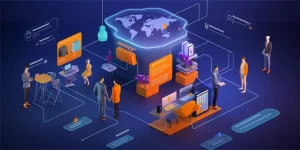Introduction
Third-party logistics (3PL) providers play a crucial role in the supply chain management process. They offer services ranging from warehousing and transportation to inventory management and order fulfillment. However, have you ever wondered how 3PL providers make money? In this article, we will explore the various revenue streams and business models that contribute to their financial success.

Services Offered
One of the primary ways 3PL providers generate revenue is by offering a wide range of services. This includes transportation management, warehousing, order fulfillment, inventory management, and value-added services such as packaging, labeling, and customization. By providing a comprehensive suite of services, 3PL providers can cater to the diverse needs of their clients and generate revenue through service fees or contracts.
Furthermore, some 3PL providers may specialize in specific industries or offer niche services, such as cold chain logistics or hazardous material handling. These specialized services can command premium pricing, leading to increased profitability.
Transportation Costs
Transportation costs constitute a significant portion of a 3PL provider’s revenue. They earn money through freight charges, which may be based on factors like distance, weight, mode of transportation, and urgency of delivery. Additionally, 3PL providers can negotiate favorable rates with carriers by leveraging their expertise and strong relationships. The difference between the negotiated rate and the cost charged to the client represents their profit.
Some 3PL providers also operate their own fleet of trucks or have partnerships with freight brokers, allowing them to control transportation costs better while offering competitive pricing to clients.
Warehousing and Storage
Another crucial revenue source for 3PL providers is warehousing and storage fees. They earn money by charging clients for storing their products in warehouses and distribution centers. The fee structure is typically based on factors like space occupied, duration of storage, and additional services required, such as inventory management or order processing.
By efficiently managing warehouse space and optimizing storage utilization, 3PL providers can generate maximum revenue from this stream. They may also offer value-added services like cross-docking, kitting, and repackaging for an additional fee.
Technology and Systems
In today’s digital age, many 3PL providers rely on advanced technology and systems to streamline operations and provide enhanced visibility to clients. They generate revenue by offering access to their technology platforms or by incorporating technology-related fees into their service contracts.
These technology solutions include warehouse management systems (WMS), transportation management systems (TMS), order tracking and visibility tools, and analytics platforms. By charging for the use of these solutions, 3PL providers can supplement their revenue while providing a competitive edge to their clients.
Supply Chain Consultancy
3PL providers often possess deep expertise in supply chain management. They can generate revenue by offering consultancy services to clients looking to optimize their supply chain operations. This may involve conducting performance audits, identifying areas for improvement, developing customized solutions, and implementing industry best practices.
By leveraging their knowledge and experience, 3PL providers can advise clients on cost reduction strategies, process optimization, and supply chain sustainability initiatives. These consultancy services can be billed separately or bundled with other services, creating additional revenue opportunities.
Value-Added Services
Many 3PL providers offer value-added services that go beyond traditional logistics offerings. These additional services can include product customization, assembly, packaging, labeling, returns management, and reverse logistics. By providing these value-added services, 3PL providers can differentiate themselves in the market and charge premium prices.
For example, by offering customized packaging options, a 3PL provider can help clients make their products stand out on retail shelves. Similarly, efficient returns management can save clients time and money, leading to customer satisfaction and repeat business.
Global Expansion and Cross-Border Services
In our global economy, 3PL providers that offer cross-border services can tap into a significant revenue stream. They facilitate international trade by managing complex customs regulations, handling documentation, and providing transportation solutions for cross-border logistics.
Revenue is generated through various means, including international freight forwarding, import/export duties, customs brokerage, and compliance services. By specializing in cross-border logistics, 3PL providers can position themselves as trusted partners for businesses looking to expand their global reach.
Contractual Agreements
Many 3PL providers secure long-term contractual agreements with clients, ensuring a steady revenue stream. These contracts may span multiple years and cover a range of services. By securing such agreements, 3PL providers can forecast their revenue and allocate resources accordingly.
Contractual agreements also offer stability and enable 3PL providers to build strong relationships with clients. They can leverage this trust to upsell additional services or negotiate higher pricing for value-added offerings.
Risk Management
3PL providers take on various risks while managing their clients’ supply chains. These risks, such as inventory loss, damage, or delay in delivery, can result in financial liabilities. To mitigate these risks, 3PL providers may offer insurance coverage or include indemnification clauses in their contracts.
By providing risk management solutions, 3PL providers not only protect themselves but also generate additional revenue. Insurance premiums or risk management fees contribute to their overall profitability.
Customer Retention and Expansion
Repeat business and customer loyalty are vital for 3PL providers. By consistently delivering high-quality services, meeting clients’ expectations, and fostering strong relationships, 3PL providers can retain their customers and expand their revenue base.
Satisfied clients are more likely to recommend 3PL providers to their industry peers, leading to organic business growth. Customer retention also reduces marketing and sales expenses, allowing 3PL providers to focus on providing excellent service and generating more revenue from existing clients.
Conclusion
3PL providers employ various strategies and revenue models to make money in the logistics industry. Through service offerings, transportation costs, warehousing, technology solutions, consultancy, value-added services, cross-border expertise, contractual agreements, risk management, and customer retention, 3PL providers maximize their revenue while delivering exceptional supply chain solutions to clients.
Frequently Asked Questions
1. How do 3PL providers earn money?
3PL providers generate revenue through a combination of services offered, transportation costs, warehousing and storage fees, technology solutions, consultancy services, value-added services, cross-border expertise, contractual agreements, risk management solutions, and customer retention and expansion.
2. What are value-added services offered by 3PL providers?
Value-added services can include product customization, assembly, packaging, labeling, returns management, and reverse logistics. These additional services go beyond traditional logistics offerings and allow 3PL providers to charge premium prices.
3. How do 3PL providers manage risks in supply chain management?
3PL providers may offer insurance coverage, include indemnification clauses in contracts, or implement robust risk management strategies to mitigate risks associated with inventory loss, damage, or delays in delivery.
References
1. Supply Chain 24/7
2. Inbound Logistics
3. Journal of Supply Chain Management








